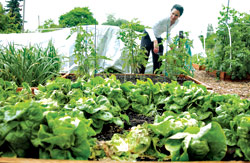At the Aloha Inn in Lower Queen Anne, residents of a transitional housing program are served a fresh green salad every night thanks to gardeners at the Queen Anne and Interbay P-Patches, two of Seattle’s 65 community gardens. At the University District Food Bank, fresh vegetables—still speckled with bits of moist, local soil—bring the scent of a farmers market to the standard packaged food offerings. These are just two ways that local farmers and P-Patch gardeners share the bounty of verdant Cascadia with the less fortunate. As the gardening and market season kicks into high gear, their efforts are increasingly visible. (For non–green thumbs: The “P” in P-Patch is for Picardo, the Seattle family that originally made land available for a shared garden in the ’70s.)
John Hale, a Lake City resident who’s a customer and a volunteer at the University District Food Bank, took home fresh asparagus last week and gave it rave reviews. His favorite market items are tomatoes, peaches, and green beans, but he and other shoppers will experiment with unusual greens that are sometimes donated, even though “half of us don’t know what they are.”
The end user isn’t the only one with the potential to be satisfied. “The P-Patches do an awesome job of getting fresh food to me and other shelters who fix meals,” says Toni Forbes, Aloha Inn’s kitchen organizer. “The fresh produce and herbs I get from them help me out tremendously.”
Local farmers also are gift-givers, often donating produce at the end of a market day. “I don’t think you’re going to find a farmer out there who doesn’t send produce to the food bank,” says Luke Woodard of Oxbow Farm in the Snoqualmie Valley. “The rise of the farmers markets, that’s a new donation stream for us, in the last six to 10 years,” says Joe Gruber, executive director of the University District Food Bank. “Food from the farmers was increasing every year until last year. The reason it decreased is the success of the farmers market itself.”
Gruber says many of his clients respond to the local, fresh food. “It’s an opportunity to see food that isn’t in a can.” The seasonality of the produce and the fact that “it’s visually, tactilely different” than prepackaged grocery-store produce make it go quickly.
Most vendors at farmers markets also take vouchers from WIC and senior-nutrition and food-stamp programs, although some markets are still challenged with accepting electronic benefits transfer (EBT) cards. The University District Food Bank even issues its own farmers market coupons.
In addition to donating market produce to an at-risk youth program after his day at the Olympia Farmers Market, Mike Peroni of Boistfort Valley Farm in Lewis County contributes a couple of community supported agriculture (CSA) subscriptions to local nonprofit organizations each year. Lately, he says, the practice has caught on with his customers. “This year, we’ve noticed an increase in people calling up and getting a CSA share for themselves and a share for a soup kitchen or for a shelter,” he says.
Many food banks are supported by P-Patchers and backyard gardeners, who last year collectively donated more than 40,000 pounds of produce in Seattle. Lettuce Link, a program of the Fremont Public Association that supports the produce- giving program, operates a three-quarter-acre food-bank garden at Marra Farm in South Park, tended by swarms of corporate volunteer groups. Lettuce Link dispenses information about growing for a food bank at www.fremontpublic.org.
The organization also distributes seeds and plant starts to low-income people who want to grow their own. “The immigrant population tends to be most excited about the seeds and starts we bring to the food banks,” says program manager Michelle Bates-Benetua. Limited-income people with health problems also gravitate toward tending a garden, she says.
The ability to have fresh produce injects “an element of normalcy” into the lives of people forced to shop at food banks, Gruber says. “You don’t feel like you’re making quite a concession to your diet, your nutrition, and your family’s health that you have to make on other days. I think that’s important for your mental well-being as well as your nutritional well-being.”
Gardening author Steve Solomon wholeheartedly agrees. “For me, gardening has never been a minor affair. It is life itself. It is independence. It is health for my family. And for people going through hard times, a thriving veggie garden can be the difference between painful poverty and a much more pleasant existence.”
In his new book, Gardening When It Counts: Growing Food in Hard Times, the Northwest gardening guru and founder of Territorial Seed Company details a plan to garden with few tools and a small investment. He also posits that peak oil prices and climate change will send more middle-class people to the garden in order to keep up healthful eating. “If you make a decision to eat local, you’re going to take a big bite out of this petro-based economy,” says Woodard.
Whether growing your own, shopping at farmers markets, or supporting programs that bring local food to those who can’t afford it, there are many ways your toil can contribute to another’s table.




